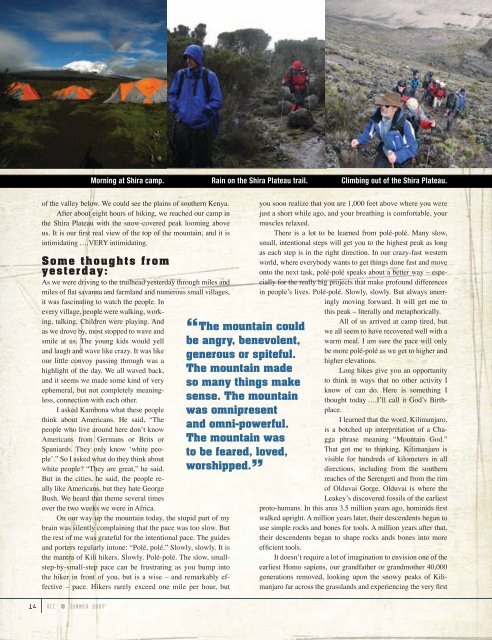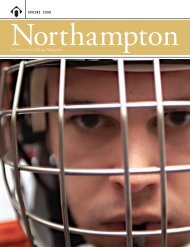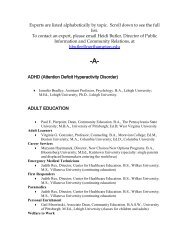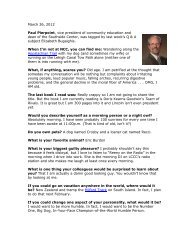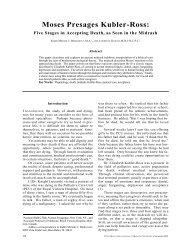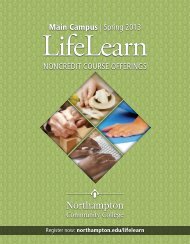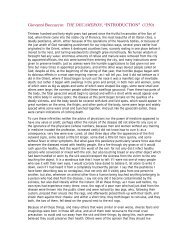INTERNATIONALADVENTURE - Northampton Community College
INTERNATIONALADVENTURE - Northampton Community College
INTERNATIONALADVENTURE - Northampton Community College
You also want an ePaper? Increase the reach of your titles
YUMPU automatically turns print PDFs into web optimized ePapers that Google loves.
of the valley below. We could see the plains of southern Kenya.<br />
After about eight hours of hiking, we reached our camp in<br />
the Shira Plateau with the snow-covered peak looming above<br />
us. It is our fi rst real view of the top of the mountain, and it is<br />
intimidating ….VERY intimidating.<br />
Some thoughts from<br />
yesterday:<br />
As we were driving to the trailhead yesterday through miles and<br />
miles of fl at savanna and farmland and numerous small villages,<br />
it was fascinating to watch the people. In<br />
every village, people were walking, work-<br />
ing, talking. Children were playing. And<br />
as we drove by, most stopped to wave and<br />
smile at us. The young kids would yell<br />
and laugh and wave like crazy. It was like<br />
our little convoy passing through was a<br />
highlight of the day. We all waved back,<br />
and it seems we made some kind of very<br />
ephemeral, but not completely meaningless,<br />
connection with each other.<br />
I asked Kambona what these people<br />
think about Americans. He said, “The<br />
people who live around here don’t know<br />
Americans from Germans or Brits or<br />
Spaniards. They only know ‘white people’.”<br />
So I asked what do they think about<br />
white people? “They are great,” he said.<br />
But in the cities, he said, the people really<br />
like Americans, but they hate George<br />
Bush. We heard that theme several times<br />
over the two weeks we were in Africa.<br />
On our way up the mountain today, the stupid part of my<br />
brain was silently complaining that the pace was too slow. But<br />
the rest of me was grateful for the intentional pace. The guides<br />
and porters regularly intone: “Polé, polé.” Slowly, slowly. It is<br />
the mantra of Kili hikers. Slowly. Polé-polé. The slow, smallstep-by-small-step<br />
pace can be frustrating as you bump into<br />
the hiker in front of you, but is a wise – and remarkably effective<br />
– pace. Hikers rarely exceed one mile per hour, but<br />
14 NCC ● SUMMER 2007<br />
Morning at Shira camp. Rain on the Shira Plateau trail. Climbing out of the Shira Plateau.<br />
“ The mountain could<br />
be angry, benevolent,<br />
generous or spiteful.<br />
The mountain made<br />
so many things make<br />
sense. The mountain<br />
was omnipresent<br />
and omni-powerful.<br />
The mountain was<br />
to be feared, loved,<br />
worshipped.”<br />
you soon realize that you are 1,000 feet above where you were<br />
just a short while ago, and your breathing is comfortable, your<br />
muscles relaxed.<br />
There is a lot to be learned from polé-polé. Many slow,<br />
small, intentional steps will get you to the highest peak as long<br />
as each step is in the right direction. In our crazy-fast western<br />
world, where everybody wants to get things done fast and move<br />
onto the next task, polé-polé speaks about a better way – especially<br />
for the really big projects that make profound differences<br />
in people’s lives. Polé-polé. Slowly, slowly. But always unerringly<br />
moving forward. It will get me to<br />
this peak – literally and metaphorically.<br />
All of us arrived at camp tired, but<br />
we all seem to have recovered well with a<br />
warm meal. I am sure the pace will only<br />
be more polé-polé as we get to higher and<br />
higher elevations.<br />
Long hikes give you an opportunity<br />
to think in ways that no other activity I<br />
know of can do. Here is something I<br />
thought today ….I’ll call it God’s Birthplace.<br />
I learned that the word, Kilimanjaro,<br />
is a botched up interpretation of a Chagga<br />
phrase meaning “Mountain God.”<br />
That got me to thinking. Kilimanjaro is<br />
visible for hundreds of kilometers in all<br />
directions, including from the southern<br />
reaches of the Serengeti and from the rim<br />
of Olduvai Gorge. Olduvai is where the<br />
Leakey’s discovered fossils of the earliest<br />
proto-humans. In this area 3.5 million years ago, hominids fi rst<br />
walked upright. A million years later, their descendents began to<br />
use simple rocks and bones for tools. A million years after that,<br />
their descendents began to shape rocks ands bones into more<br />
effi cient tools.<br />
It doesn’t require a lot of imagination to envision one of the<br />
earliest Homo sapiens, our grandfather or grandmother 40,000<br />
generations removed, looking upon the snowy peaks of Kilimanjaro<br />
far across the grasslands and experiencing the very fi rst


